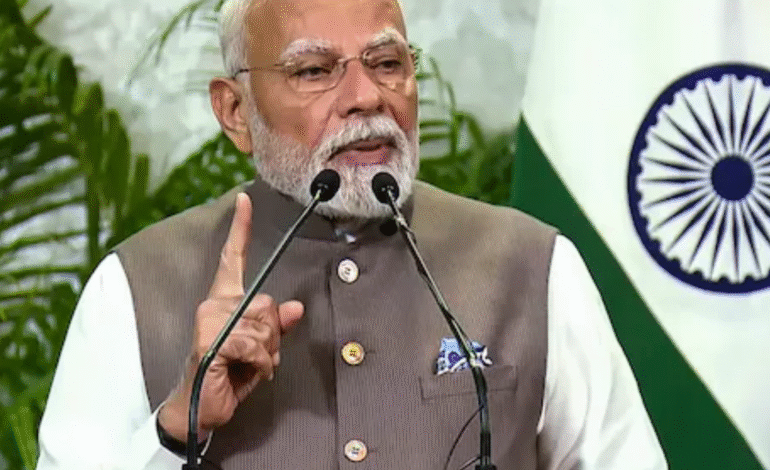India’s 2025 Swadeshi Campaign: Boosting Indigenous Products, Economy

India is witnessing a powerful resurgence of the Swadeshi movement in 2025, as the nation rallies behind Prime Minister Narendra Modi’s call to prioritize indigenous products. Launched during the 20th instalment of the PM-Kisan Samman Nidhi in Varanasi, this initiative is gaining momentum with support from Union ministers, state leaders, and national trade associations. Aimed at strengthening the Indian economy, supporting local producers, and fostering self-reliance, the campaign is a strategic move to position India as a global economic powerhouse. This article explores the Swadeshi campaign 2025, its implications for local manufacturing, and how it aligns with the vision of Aatmanirbhar Bharat.
A Strategic Vision for Economic Growth
The Swadeshi campaign is more than a call to action; it’s a strategic effort to bolster India’s economic growth and empower local industries. Prime Minister Modi’s appeal emphasizes the importance of choosing Made in India products to keep wealth within the country and create job opportunities for Indian citizens. Union Agriculture Minister Shivraj Singh Chouhan reinforced this message, urging citizens to prioritize indigenous goods to support farmers, artisans, and small businesses. “Why should our money go abroad? Let it provide livelihoods to our own children,” Chouhan said, highlighting the campaign’s focus on economic self-reliance.
With India’s economy currently ranked as the fourth largest globally, Chouhan noted that a concerted effort to support local products could propel the nation to the third spot. The campaign leverages India’s massive domestic market of 1.44 billion people, encouraging consumers to drive demand for Indian-made goods. This push aligns with the broader vision of Aatmanirbhar Bharat, which seeks to make India a self-reliant manufacturing hub. By fostering local production, the initiative aims to reduce dependency on foreign goods, strengthen supply chains, and enhance cultural preservation.
“Indian Goods – Our Pride” Campaign
The Confederation of All India Traders (CAIT) has taken a leading role in amplifying the Swadeshi movement by launching a nationwide campaign titled “Indian Goods – Our Pride”, set to begin on August 10, 2025. Spearheaded by CAIT Secretary General and MP Praveen Khandelwal, the campaign will engage over 48,000 trade associations across the country to promote the sale and consumption of indigenous products. Announced at the National Traders Conference in New Delhi, attended by 150 trade leaders from 26 states, the initiative is a bold step toward realizing Aatmanirbhar Bharat.
The campaign will feature rallies, social media drives, and awareness programs in schools, colleges, and marketplaces. Retail spaces will prominently display the slogan “Only Indian Goods Sold Here”, encouraging consumers to embrace Swadeshi products. CAIT leaders emphasize that supporting Indian goods not only fuels economic growth but also preserves cultural heritage and protects local industries from monopolistic foreign practices. By promoting indigenous manufacturing, the campaign aims to create a robust ecosystem that supports job creation and economic resilience.
Economic Impact and Job Creation
The Swadeshi campaign is poised to have a transformative impact on India’s economy. By prioritizing indigenous products, the initiative seeks to address the trade deficit caused by the consumption of foreign goods. Khandelwal noted that Indian products today match global standards in quality and are competitively priced, making them a viable alternative to imported goods. This shift is expected to benefit local artisans, entrepreneurs, and traders, while fostering innovation in small and medium enterprises (SMEs).
The campaign’s focus on job creation is particularly significant. By increasing demand for Made in India products, the initiative will create opportunities for farmers, weavers, craftsmen, and small business owners. This aligns with the government’s broader goal of boosting the manufacturing sector’s contribution to GDP, which was targeted to reach 25% by 2025 under the Make in India initiative. Although the manufacturing sector’s GDP share has slightly declined from 16.7% in 2013–2014 to 15.9% in 2023–2024, the Swadeshi campaign aims to reverse this trend by encouraging domestic consumption and investment.
Political Context and Economic Resilience
The Swadeshi movement comes amid political debates, with BJP leaders countering opposition claims about the state of India’s economy. Congress MP Rahul Gandhi recently labeled the economy as “dead,” a remark echoed by US President Donald Trump. In response, Union Minister Hardeep Singh Puri and Maharashtra Chief Minister Devendra Fadnavis cited the IMF World Economic Outlook, which projects India’s growth rate at 6.4% in 2025 and 2026, the highest among major economies. This robust growth underscores India’s position as the fastest-growing economy globally, driven by structural reforms and focused governance.
Fadnavis highlighted India’s rise from the 11th largest economy in 2013–2014 to the fifth largest, with the fourth spot now within reach. Assam Chief Minister Himanta Biswa Sarma emphasized the country’s transformation from the “Fragile Five” label a decade ago to a resilient economic powerhouse. The Swadeshi campaign reinforces this narrative, showcasing India’s ability to thrive despite global uncertainties and positioning it as a reliable partner for global investors.
Aligning with Mak e in India and Aatmanirbhar Bharat
The Swadeshi campaign builds on the foundation of the Make in India initiative, launched in 2014 to boost manufacturing and attract foreign direct investment(FDI). While Make in India aimed to increase the manufacturing sector’s GDP contribution to 25% by 2022 (later revised to 2025), challenges remain, as the sector’s share has slightly declined. However, successes such as India surpassing China as the top smartphone exporter to the US in 2025, driven by Apple’s manufacturing shift, highlight the initiative’s potential.
The Aatmanirbhar Bharat vision complements these efforts by promoting self-reliance across sectors. From indigenous tarmac coaches by Veera Vahana Udyog Pvt Ltd to electrical harnesses for Airbus and Boeing, Indian manufacturers are proving their mettle on the global stage. The Swadeshi campaign amplifies these achievements by encouraging consumers to support local products, from handicrafts and textiles to traditional foods like Pitha, Gushtaba, and Khakhra.
Engaging the Youth and Digital Platforms
A key feature of the “Indian Goods – Our Pride” campaign is its focus on engaging young Indians through social media and educational initiatives. By leveraging platforms like Instagram, Twitter, and LinkedIn, CAIT aims to create a digital movement that resonates with the tech-savvy generation. Awareness programs in schools and colleges will educate students about the importance of Swadeshi products, fostering a sense of national pride and economic responsibility.
The campaign’s social media drives will use hashtags like #Swadeshi2025, #MadeInIndia, and #AatmanirbharBharat to amplify its reach. Retailers will also play a crucial role by displaying banners and promoting Indian goods in their stores. This multi-pronged approach ensures that the Swadeshi movement connects with diverse audiences, from urban consumers to rural producers.
Challenges and Opportunities
While the Swadeshi campaign holds immense potential, challenges remain. The Make in India initiative, for instance, faced hurdles in achieving its manufacturing GDP target, with logistical and infrastructural constraints cited as key barriers. Similarly, the Swadeshi campaign must address issues like supply chain disruptions and market access for small-scale producers. Ensuring that indigenous products are competitively priced and widely available will be critical to its success.
However, the opportunities outweigh the challenges. India’s retail sector is projected to reach $2 trillion by 2032, with the e-commerce market expected to grow to $85.5 billion by 2025. By promoting indigenous products through e-commerce platforms and D2C brands, the campaign can tap into this growth. Initiatives like the One Station One Product (OSOP) scheme by Indian Railways, which promotes local products at railway stations, demonstrate the potential for innovative marketing strategies.
The Role of Government and Industry
The government’s role in the Swadeshi campaign is pivotal. Policies that simplify export procedures, reduce logistics costs, and provide credit access to SMEs will enhance the campaign’s impact. The Union Budget 2023 emphasized support for e-commerce and D2C brands, which can be leveraged to promote indigenous products globally. Additionally, incubation centers and upskilling programs can nurture entrepreneurs and strengthen the manufacturing ecosystem.
Industry leaders are also stepping up. Companies like Apple, Microsoft, and NTT Data are expanding operations in India, aligning with the Make in India initiative. These investments not only boost local manufacturing but also create job opportunities and enhance technological capabilities. By supporting indigenous brands, these corporations can contribute to the Swadeshi movement and drive economic growth.
A Call to Action for Every Indian
The Swadeshi campaign 2025 is a call to action for every Indian to embrace Made in India products and contribute to national prosperity. By choosing indigenous goods, consumers can support local communities, preserve cultural heritage, and strengthen the economy. As Prime Minister Modi emphasized in his Mann Ki Baat address in 2019, the spirit of Swadeshi is about celebrating the “fragrance of the sweat of our countrymen.” This sentiment resonates today as India strives for self-reliance and global leadership.
A Bright Future for Indigenous Products
India’s Swadeshi campaign 2025 is a bold step toward economic self-reliance and global competitiveness. With Dh151 billion in sales, 90,337 new units, and a thriving rental market, the emirate is setting new benchmarks for real estate excellence. By promoting indigenous products, the campaign empowers farmers, artisans, and small businesses, while fostering job creation and cultural preservation. Supported by government policies, industry leaders, and a digital movement, the initiative is poised to transform India’s economic landscape.
For consumers, businesses, and investors, the Swadeshi movement offers a unique opportunity to contribute to Aatmanirbhar Bharat. Whether you’re buying handicrafts, supporting local brands, or advocating for Made in India, your choices can shape the future. Stay updated with hammermindset.com for the latest insights on India’s economic trends and business opportunities in the Middle East.








1 Comment
[…] India and China have decided to give their relationship a fresh push. After years of tension, leaders from both countries met in New Delhi and reached important agreements. […]
Comments are closed.